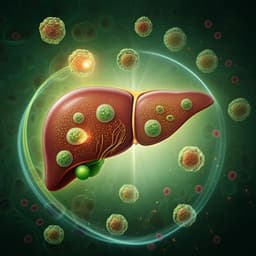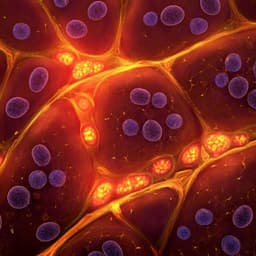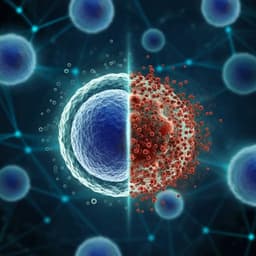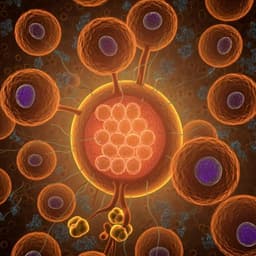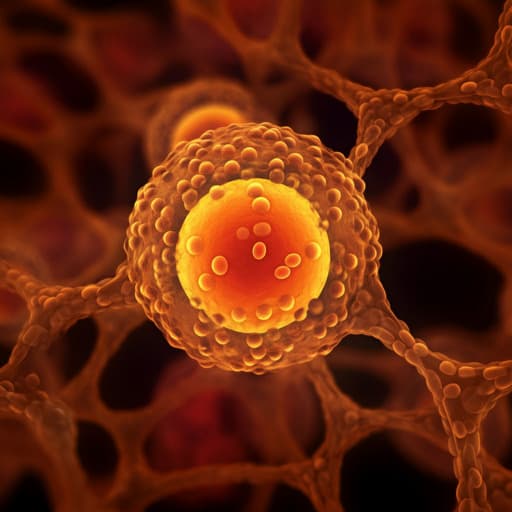
Medicine and Health
Perilipin 5 regulates hepatic stellate cell activation and high-fat diet-induced non-alcoholic fatty liver disease
X. Yin, L. Dong, et al.
Unlock the secrets of nonalcoholic fatty liver disease (NAFLD) with groundbreaking research by Xuecui Yin and colleagues. This study reveals how Perilipin 5 influences hepatic stellate cell activation, impacting lipid homeostasis, glucose regulation, and mitochondrial health. Discover the potential of PLIN5 in combating liver fibrosis and enhancing metabolic performance!
~3 min • Beginner • English
Introduction
NAFLD ranges from simple steatosis to non-alcoholic steatohepatitis (NASH), with a subset progressing to fibrosis, cirrhosis, and hepatocellular carcinoma. Hepatic stellate cells (HSCs) are central to hepatic fibrogenesis: in quiescence they store retinol-rich lipid droplets, but upon chronic injury they activate into myofibroblast-like cells, lose LDs, and upregulate α-SMA and type I collagen, driving extracellular matrix accumulation. While genes promoting HSC activation are increasingly defined, effective anti-fibrotic therapies remain limited. Perilipin 5 (PLIN5) coats lipid droplets storing neutral lipids and regulates lipid homeostasis; PLIN5’s roles in hepatocytes, heart, skeletal muscle, and islets involve lipid metabolism and mitochondrial regulation. Intracellular lipid content influences HSC activation, and PLIN5 has been suggested to inhibit HSC activation, but its role in apoptosis of activated HSCs remains unclear. This study investigates how PLIN5 regulates HSC activation and survival in vitro and examines the impact of PLIN5 deletion on HFD-induced NAFLD and fibrosis in vivo.
Literature Review
The perilipin family (PLIN1–5) governs lipid droplet biology and intracellular lipolysis. PLIN5 localizes to LD–mitochondria contact sites and modulates lipid metabolism and mitochondrial function in metabolic tissues. Prior studies indicate LD dynamics influence HSC activation; interventions that increase intracellular lipids in HSCs (e.g., curcumin) can blunt activation. In hepatocytes, PLIN5 signaling via SIRT1 promotes autophagy and mitigates inflammation during fasting, and PLIN5 deletion can remodel hepatic lipid metabolism and affect insulin sensitivity. AMPK is a central energy sensor; its activation reduces HSC proliferation and promotes apoptosis, offering anti-fibrotic potential. Mitochondrial dysfunction and oxidative stress are implicated in NAFLD progression; glutathione metabolism is key for redox balance and cell survival. Despite indications that PLIN5 may restrain HSC activation, its mechanistic links to AMPK, mitochondrial function, and apoptosis in HSCs, and its net role in NAFLD in vivo, have not been fully delineated.
Methodology
- Animals: Male Sprague–Dawley rats (6–8 weeks) and C57BL/6J mice were used. PLIN5−/− mice were generated and validated at gene/protein levels. Four-week-old mice were randomized to normal diet (ND) or high-fat diet with high-fructose corn syrup (HFD; 45% energy from fat) for 20 weeks (n=10/group; 4 groups). Animal procedures were approved (Zhengzhou University KY2022045).
- HSC isolation and culture: Rat HSCs were isolated by in situ pronase–collagenase perfusion followed by density gradient centrifugation. Cells were cultured in low-glucose DMEM with 10% FBS for 1 day (quiescent-like, D1), 7 days (activated, D7), or passaged 4–9 times (fully activated, rHSC-primary). Oleic acid (OA) supplementation was used (typically 20 μM with PLIN5 overexpression; 100 μM as control) to probe LD formation.
- PLIN5 overexpression: Lentiviral vector pFLRu-PLIN5 (constructed by cloning rat PLIN5 cDNA into pFLRu using EcoRI and AgeI sites) was used to transduce activated rHSC-primary cells (e.g., 5×10^5 TU/mL). Transduction efficiency was confirmed by qPCR and western blot.
- Biochemical assays: Triglycerides (TG; Solarbio), reduced glutathione (GSH; Beyotime), caspase-3 activity (EnzChek, Invitrogen), and ATP levels (ATP Determination Kit, Invitrogen) were measured per manufacturer instructions.
- Mitochondrial analyses: Mitochondria were isolated from fresh HSCs (Solarbio kit). Mitochondrial DNA copy number was quantified by qPCR (mtDNA vs nDNA, SYBR Green). Citrate synthase activity was assessed (Figure S4). PGC-1α expression was measured by qPCR and western blot.
- Pharmacologic modulators: AMPK activation/inhibition was probed using AICAR (1 mM) and compound C (10 μM), respectively. The pan-caspase inhibitor Z-VAD-FMK (50 μM) tested caspase dependence. Mitochondrial metabolism was augmented with methyl pyruvate (MP; 1 mM) to assess rescue of PLIN5 effects.
- Histology: Liver sections (6 μm) were stained with H&E (steatosis), Masson’s trichrome and Sirius Red (fibrosis/collagen). LD number/size and fibrotic foci were quantified blindly.
- Metabolomics: Untargeted UPLC–MS/MS (Thermo Dionex Ultimate 3000 coupled to Q-Exactive) in ESI+ and ESI− modes using ACQUITY BEH C8 and HSS T3 columns. Data underwent multivariate analyses (OPLS-DA, permutation tests) and identification via METLIN/HMDB. Pathway enrichment was performed; key metabolites/pathways were validated by biochemical assays and qPCR (e.g., GSH, Gclc/Gclm).
- Molecular analyses: Western blots probed fibrotic markers (α-SMA, COL1A1), cell cycle proteins (Cyclin D1, p21), apoptosis regulators (Bcl-2, Bax, PARP; caspase-3/-9), AMPK (p-AMPK Thr172, total AMPK), and PGC-1α. Gene expression for mitochondrial biogenesis (PGC-1α, mtTFA, UCP1), oxidative stress (Gstm3, Gpx3, Cbr3), proliferation (Mcm2/4/6), inflammatory mediators (Cxcl14, Cxcl2, Ly6c, TNFα, Ccr2) and lipid metabolism were assessed by RT-qPCR.
- Glucose homeostasis: Intraperitoneal glucose tolerance test (IPGTT) and insulin tolerance test (ITT) evaluated systemic metabolism.
- Statistics: Mean ± SD; one-way ANOVA with Tukey’s post hoc for multi-group comparisons; Student’s t-test for two-group comparisons (IBM SPSS 24). P<0.05 considered significant. Metabolomics processed in SIMCA-P (v14.1).
Key Findings
- PLIN5 expression and HSC activation: PLIN5 mRNA was highest in visceral fat, lower in normal liver, and decreased markedly during HSC activation. It was nearly undetectable in fully activated primary HSCs and HSC lines (GRX, T6). In HSCs from HFD-fed mice, PLIN5 decreased ~90% and PLIN2 decreased ~40% versus ND.
- Anti-proliferative effect of PLIN5 in activated HSCs: Lentiviral PLIN5 overexpression inhibited rHSC-primary proliferation (MTS), suppressed α-SMA and collagen (COL1A1), reduced Cyclin D1, increased p21, and induced G0/G1 arrest. PLIN5 facilitated LD formation in activated HSCs; TG levels increased with 20 μM OA + PLIN5 and with 100 μM OA.
- PLIN5 induces caspase-dependent apoptosis: Caspase-3 activity increased after PLIN5 overexpression, detectable by 12 h and peaking between 18–48 h. Apoptotic signaling included changes in Bcl-2/Bax, PARP cleavage, and activation of caspase-3/-9. Pan-caspase inhibitor Z-VAD-FMK abrogated PLIN5-induced apoptosis and proliferation arrest.
- AMPK is required for PLIN5 effects: PLIN5 overexpression increased AMPK phosphorylation (Thr172), mimicking AICAR’s effects (reduced proliferation, increased caspase-3). AMPK inhibition with compound C reversed PLIN5-induced apoptosis and cell cycle arrest, indicating AMPK dependence.
- Mitochondrial dysfunction underlies AMPK activation and apoptosis: PLIN5 overexpression lowered PGC-1α mRNA, decreased ATP levels, reduced mtDNA copy number and citrate synthase activity, indicating suppressed mitochondrial biogenesis and function. Augmenting mitochondrial metabolism with methyl pyruvate restored ATP production, reversed AMPK phosphorylation, and eliminated PLIN5-induced proliferation arrest and apoptosis.
- In vivo NAFLD model (HFD): Compared with HFD-fed C57BL/6J mice, HFD-fed PLIN5−/− mice showed improved glucose homeostasis (IPGTT/ITT), reduced hepatic COL1A1 and α-SMA protein levels, markedly less steatosis (WT HFD livers displayed 70–95% steatotic area), smaller and fewer hepatic LDs, reduced fibrosis and collagen deposition (Masson’s, Sirius Red), and decreased hepatic TG content. Expression of fatty acid uptake/synthesis genes was reduced in PLIN5−/− HFD livers.
- Liver metabolomics and oxidative stress: OPLS-DA revealed clear separation among ND/HFD and genotypes; 47 differential metabolites were identified. Pathway analysis highlighted glutamate/glutathione metabolism. GSH levels were significantly higher in PLIN5−/− HFD versus C57BL/6J HFD. Gclc and Gclm expression was elevated in PLIN5−/− HFD livers, consistent with preserved glutathione biosynthesis.
- AMPK/PGC-1α and apoptosis in vivo: HFD suppressed hepatic AMPK activity in WT, while PLIN5−/− HFD livers exhibited increased p-AMPK and alterations in PGC-1α and apoptosis markers; overall, PLIN5 deletion attenuated HFD-induced hepatic apoptosis and oxidative stress signatures.
Discussion
The study demonstrates that PLIN5 is downregulated during HSC activation and that restoring PLIN5 in activated HSCs suppresses proliferation and induces apoptosis via mitochondrial dysfunction-driven AMPK activation and caspase cascades. PLIN5 overexpression diminishes mitochondrial biogenesis/function (reduced PGC-1α, mtDNA copies, citrate synthase activity, ATP), thereby increasing energetic stress and activating AMPK; pharmacologic modulation confirmed AMPK’s necessity and caspase dependence. Mitochondrial substrate supplementation (methyl pyruvate) reversed these effects, pinpointing mitochondrial metabolism as a key mediator.
In vivo, whole-body PLIN5 deletion protected against HFD-induced NAFLD, improving glucose homeostasis, reducing steatosis, LD burden, and fibrosis, and preserving glutathione metabolism. Metabolomics highlighted glutathione pathway involvement and supported antioxidant preservation in PLIN5−/− livers. Although in vitro PLIN5 promoted apoptosis in activated HSCs, whole-body PLIN5 deletion ameliorated NAFLD pathology, reflecting cell-type-specific roles (e.g., hepatocytes versus HSCs) and systemic metabolic effects that dominate in vivo. These findings underscore PLIN5 as a regulator of HSC activation via AMPK–mitochondrial signaling while also implicating PLIN5 in broader hepatic metabolic and redox homeostasis influencing NAFLD progression.
Conclusion
PLIN5 is a negative regulator of HSC activation: its overexpression in activated HSCs suppresses proliferation and triggers caspase-dependent apoptosis via mitochondrial dysfunction and AMPK activation. Conversely, whole-body PLIN5 deletion mitigates HFD-induced NAFLD, reducing steatosis and fibrosis and preserving glutathione metabolism, highlighting complex, cell-type-specific roles of PLIN5 in liver pathophysiology. Future work should deploy hepatocyte- and HSC-specific PLIN5 knockout models to disentangle cell-autonomous effects, further resolve AMPK–PGC-1α–mitochondrial interactions, and explore therapeutic strategies modulating PLIN5 or downstream pathways for anti-fibrotic and metabolic benefits.
Limitations
A principal limitation is the use of whole-body PLIN5 knockout mice, which affects multiple cell types (hepatocytes constitute ~70% of liver cells, HSCs ~8–13%). This complicates interpretation of cell-specific roles and contributes to apparent discrepancies between in vitro HSC data (pro-apoptotic effects of PLIN5 overexpression) and in vivo outcomes (global PLIN5 deletion protective against NAFLD). Additional limitations include reliance on rodent models and lack of tissue-specific genetic manipulation; future studies with hepatocyte- or HSC-specific PLIN5 deletions are needed.
Related Publications
Explore these studies to deepen your understanding of the subject.



